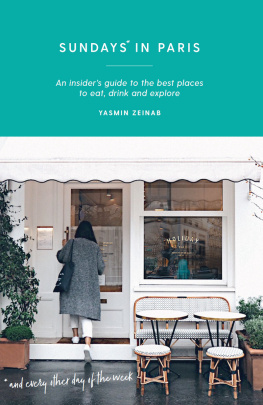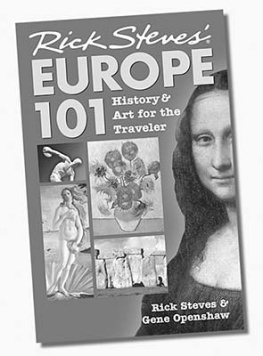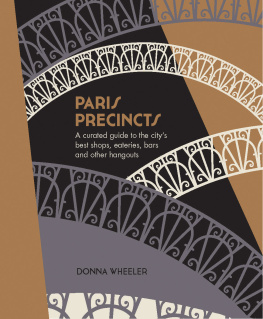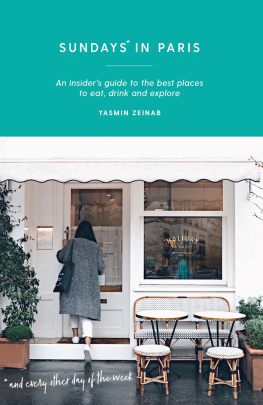All rights reserved. No part of this publication may be reproduced, stored in a retrieval system or transmitted in any form by any means, electronic, mechanical, photocopying, recording or otherwise, without the prior written permission of the publishers and copyright holders.
Contents
Sundays in Paris was born while I was wandering the streets of Saint-Germain-des-Prs with a friend one Sunday. I have always loved lazy Sunday morning rituals lingering over coffee and partaking in brunches that run long into the afternoon so when I moved from Lyon to Paris, I was excited by the weekend adventures a bigger city would bring. But what I encountered as I explored the city was an abundance of closed signs.
While so much of Paris is closed on Sundays, I discovered bustling pockets of activity behind the seemingly sleepy faade, filled with Parisians enjoying their weekends in cafs and eateries across the city. So each Sunday, I set out to explore what was open. Before long, I had scribbled lists of spots to try in notebooks and on scraps of paper around my apartment. I constantly asked friends to join me at newly discovered venues and revisit old-time favourites; they joked about my obsession, but happily obliged. Working freelance at the time meant I spent my Sundays (and most other days of the week) caf hopping, discovering new eateries and making friends with the baristas, restaurateurs and bartenders behind some of the citys best venues. I began documenting my discoveries on social media and before long Sundays in Paris had taken on a life of its own.
Over the years, I have been fortunate to meet and work with the incredible community behind Paris growing specialty coffee and food scene. In this book, I share my love for Sundays spent in a city that has captivated me since the moment I first arrived. While initially curated as a list of the best places open on Sundays in Paris, this guide is a collection of venues and itineraries that are great for any day of the week.
Welcome to the City of Light
Paris started out as a walled settlement on le de la Cit, one of the river Seines two natural islands, with marshlands to the north and fields and vineyards to the south. The settlements tightly wound core expanded quickly, starting in the Medieval period, and was divided into administrative areas we now call arrondissements. Baron Haussmann rebuilt much of the city in the 1850s and 1860s at the behest of then-Emperor Louis-Napolon (nephew of Napolon Bonaparte), expanding its boundaries into the shape we recognise today: 20 arrondissements that spiral outwards in a clockwise direction. Despite its size, Paris has managed to retain a sense of small-town charm. The arrondissements each boast their own unique characteristics and subculture, making each one distinct from the next. The Seine gives the city a further distinction, cutting it neatly into two halves: the sophisticated, moneyed Left Bank and the diverse, trendy Right Bank, each full of endless sights to explore.
The central 1st arrondissement is home to sprawling gardens, countless monuments and the worlds largest museum. This hive of activity is also home to luxury boutiques and high-end hotels, filled with tourists and shoppers who flock to the area due to its central location.
The neighbouring 2nd arrondissement has a business district at its core, with pockets of eateries and shopping at its edges. One of the few areas in Paris without a major tourist attraction, the 2nd is a great place to escape the main tourist crush and enjoy the lively atmosphere of Parisians going about their everyday lives.
The historic-turned-trendy 3rd arrondissement, also known as Le Marais, has two distinct sides. Theres the Haut Marais (upper Marais), a hub for Paris creatives and fashion community that boasts countless art galleries, boutiques, bars and restaurants. Towards the Seine in the lower Marais is the Jewish Quarter, anchored by rue des Rosiers, a street lined with famous falafel shops, Jewish bakeries, restaurants and synagogues. This pocket of the 3rd has been a home to Paris Jewish community for centuries. The Marais is a magnet for coffee drinkers and foodies, brimming with specialty coffee shops and cult eateries. It spills outwards towards the Seine and into the 4th arrondissement, which holds the Seines natural islands: le Saint-Louis and part of le de la Cit (home to the cathedral Notre-Dame de Paris).
Across the Seine is the historic Latin Quarter, occupying the 5th arrondissement. Home to La Sorbonne, one of the oldest universities in the world, this neighbourhood has long been an academic centre. In the late Middle Ages, students and professors were often overheard speaking Latin, hence the areas name. The maze of narrow, cobbled stone streets and Medieval-style buildings boasts many historic monuments, museums, quaint parks, and countless casual bars and eateries. While the Latin Quarter has traditionally been a hub for students, many Parisians choose to live here because of its history and old-world charm.
Further down the boulevard youll find the heart of the 6th arrondissement: Saint-Germain-des-Prs. This area, revered for its rich artistic history and beautiful Jardin du Luxembourg, was the haunt of intellectuals and artists throughout the 20th century. Famous French and expat artists and thinkers such as Ernest Hemingway, Simone de Beauvoir and John-Paul Sartre all used its cafs as their base. The area is now a sought-after neighbourhood, filled with high-end boutiques and exclusive real estate. It maintains its artistic allure with a collection of unique galleries, small museums and bookstores. Baron Haussmann focused his renovation of the Left Bank around this area, and boulevard Saint-Germain-des-Prs in particular. In consequence, the sprawling boulevard is lined with his iconic buildings, as well as beautiful streetside cafs and traditional French brasseries that give Saint-Germain-des-Prs its special Parisian charm.
Towards the west is the prestigious 7th arrondissement, home to the Eiffel Tower, or Tour Eiffel as its known to the French. While the Iron Lady is the areas main drawcard, the 7th boasts a number of other historic monuments and museums. Those who venture away from the crowds will find a refined, affluent residential neighbourhood.
Across the Seine youll find the busy 8th arrondissement. The Champs-lyses forms the areas core, along which masses of tourists stroll between the breathtaking Arc de Triomphe and the grand Place de la Concorde.
The 8th is a major point of interest for tourists, and boasts some of Paris most sought-after shopping experiences. The Champs-lyses, avenue George V and avenue Montaigne form the Golden Triangle: three elegant streets lined with high-end boutiques. You will find many luxury hotels here, as well as chic restaurants and exclusive clubs that pull in glamorous crowds. The 8th is also one of Paris commercial centres, which means pockets of the area tend to flood with commuting office workers at peak times.
Behind the glitz and glamour of the Champs-lyses is the 9th arrondissement, another bustling neighbourhood with two distinct areas: Opra and Pigalle. The Opras main boulevard, boulevard Haussmann, is bolstered by two high-end department stores, Galeries Lafayette and Printemps. Further north, towards the iconic Moulin Rouge cabaret house, is












